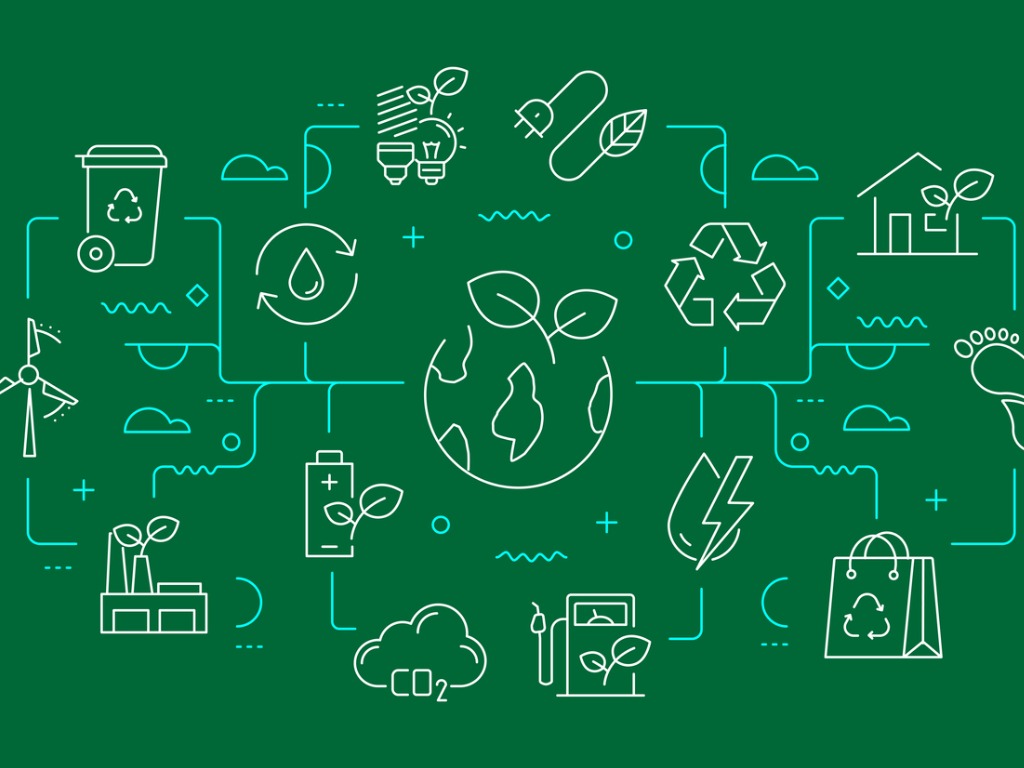
Pat Woods details eight best practices you can employ to move your organization to a more sustainable future
I am writing this article from my home office here in Costa Rica whilst dealing with the challenges of 24°C/75°F temperature year-round, three beautiful oceans, 200 volcanoes and the majority of the land mass blanketed with dense rainforests full of exotic plant and animal life. It’s a tough life, but someone has to live it! As I sit here in my little adopted country and formulate the concepts of this article, I am reminded of the words of our President, Carlos Alvarado Quesada:
“Today, humankind is in a quest for answers to the pressing convergence of crises, both sanitary and climatic as well as economic and energetic. Given our moral authority in these four major areas, Costa Rica is ready to lead the process in order to achieve, by 2030, the conservation of at least 30% of land and marine areas worldwide.”
Therefore, in line with the theme of this article and noting that just as thousands of pieces make up a puzzle (representing a beautiful depiction), each of us can do our part, both at work and at home, to complete this beautiful puzzle of planet Earth. I do not plan to address your home recycling habits, but I do want to show how as an EA, you can make a strategic contribution to the green initiatives of your organization.
What Is Meant by Sustainability?
I could give you the official definition from UNESCO (addressing society, environment and economics), but perhaps a simple illustration will make more sense. Imagine that I am conducting the ACEA (Advanced Certificate for the Executive Assistant) course in your hometown and you invite me to stay over the weekend in your holiday home, which is a short drive from the training site. You indicate that you have stocked the kitchen with more than enough food and beverage and the unit has just undergone a thorough cleaning – all given to me free of charge with only the simple request that when I depart, I leave the unit exactly how I found it.
Assuming I am both a decent and appreciative fellow, I would gladly comply with your request with a heartfelt thank you for your hospitality. If just the opposite, I would eat your food, drink your beverages, break your dishes and trash your place. Think of planet Earth as that holiday home, which we check into when we are born, and then the big question arises: When it is time for checkout, how will we leave it?
This is sustainability in a nutshell. As a further explanation of our theme, borrow some color pencils and then remove the green pencil because we are going to color this completed puzzle – you guessed it – GREEN. So here, with a dash of clarity, are three common terms that are sometimes used interchangeably or in some cases even confused.
Going green
This refers to all aspects of environmentally friendly products, from fashion to buildings to the movement as a whole.
Eco-friendly
This means that a product, practice or activity will not harm the environment.
Sustainability
This is the philosophy that what we do today will not deplete resources for future generations.
So here is a key question: Is your company involved in green initiatives?
Which major companies are setting the pace with sustainability?
Company / Main Initiative
Tesla / Electric-powered vehicles
United Airlines / Fuel-efficient airplanes
Coca-Cola / Water conservation
Toyota / Carbon footprint reduction
Target / Eco-clothing
Starbucks / Coffee tables from recycled coffee grounds
Dell / Safe product disposal
McDonalds / Energy-efficient appliances
Bank of America / Electronic statements
Google / Energy-efficient data centers
If you work for any of these companies, then congratulations and keep up the good work. If not, what role can you as an EA have in these exciting and value-contributing initiatives?
Best Practices
Consider these eight best practices. Some you can make a direct contribution to, and others you can champion by working with other functions in your organization.
1. Champion a Recycling Program
Perhaps not the most glamourous part of your job description, but you may wish to walk around the offices and breakrooms in your company and look for plastic containers and cardboard items in the trash can as well as organic waste (defined as food waste and food-soiled packages). Now you have a good case for recycling containers in centralized areas of your company. Other items, such as ink and toner cartridges, can be placed in special identified bins and then shipped back to the manufacturer or a designated dealer. This later activity is referred to as IR (Investment Recovery), which is noted in point 6 below.
2. Move Toward a Paperless Office
If we could get in a time machine and go back to 1975 and visit the offices of Xerox’s California Research Center, the head, George E. Pake, would tell us:
“…in 1995, my office will be completely different; there will be a TV-display terminal with a keyboard sitting on my desk. I’ll be able to call up documents from my files on the screen, or by pressing a button. I can get my mail or any messages. I don’t know how much hard copy [printed paper] I’ll want in this world.”
If Mr. Pake were alive today and paid a visit to your office or those of your senior leadership, would he still feel the same way? Here are some practical ways that the EA can move in this direction. Instead of making numerous trips to the copy machine, encourage your executives to make use of (e.g.) Google Docs, which will allow you and your colleagues to work on a document or spreadsheet in real time, or consider using a service such as Dropbox as an inexpensive way to store and share files via the cloud. If you are still in the world of faxing (the fax machine is not in a museum just yet), services such as eFax.com can send them as paperless emails.
3. Some May Refuse – But You Insist on Reuse
According to American Express, approximately 4 million pens are thrown away every day! As an alternative, can you or your colleagues purchase reusable pens? Then the cartridges can be replaced, which in the long run will be a cost savings for your organization. Other key areas, such as marker boards in place of large paper pads and taking digital notes instead of sticky notes, will go a long way to reduce the waste. What about plates, cups and cutlery in the breakroom? When these are used one time and then thrown away, the plastic material contributes to 150 million tons of waste each year (source: NRDC – Natural Resources Defense Council). Can you replace these with multiple-use, washable substitutes?
4. Plant a Great Idea
Has your organization ever thought about putting plants in the offices (or adding more to those already there)? Have you ever heard of the biophilia hypothesis? It is the suggestion that humans possess a desire to seek connections with nature.
Consider some key benefits backed up by studies:
Cleaner air
According to research from Dr. Fraser Torpy, Director of the University of Technology in Sydney, Australia, indoor plants can help reduce carbon dioxide levels by about 10% in air-conditioned offices and 25% in buildings without air conditioning.
Stress reduction
Dr. Torpy’s research also documented a 37% decrease in tension and anxiety and a 38% reduction in fatigue.
5. Don’t Procrastinate – Donate
The good news is that the EA can champion donation. If your firm is like most, you replace your computers and other electronic devices on a periodic basis. What happens to these items? Even though you might believe that your firm does not generate any hazardous waste, if put out for disposal, the innards of computers constitute hazardous waste, which can be a sticky issue with (e.g.) U.S. government EPA divisions. In contrast, you can avoid these issues by making a school or non-profit very happy and even incur a tax write-off.
Best practices 1-5 are your internal focus, whilst the following best practices are externally focused, primarily with your suppliers and vendors.
6. One Person’s Garbage Is Another Person’s Treasure – IR
This phrase is a modern version of the 17th century proverb which used “man” in place of “person,” but in the context of our discussion, we can replace “person” with “organization.” This forms the basis of IR (Investment Recovery), which in many key organizations means taking those items we don’t need any longer and selling them either back to the original suppliers or on the open market, perhaps through some type of dealer or agent. As purchasing functions become more strategic, this is becoming a major KPI (Key Performance Indicator). As an EA, you may not have direct involvement here, but you can start the conversation with the procurement department.
7. Work with Green Suppliers and Vendors
Back in the 1980s, I worked for a major U.S. manufacturing firm that pushed all of us buyers to source products from Mexico, the primary reason being Mexico had little to no standards regarding the disposal of hazardous waste. This meant that Mexican vendors could offer lower pricing than U.S. vendors since they did not have to build in the cost of EPA restrictions and dumping at EPA-approved sites. During one visit to a supplier in Mexico, I witnessed them dumping hazardous liquids into the local drainage, which would end up in the water supply of the adjoining residential neighborhoods. I think I even saw the liquid glowing!
But since waste has no knowledge of international borders, it was coming up through the water streams back to the U.S. anyhow! Fast forward to today and green initiatives are a global focus. As an example, look at the United Nations’ efforts (particularly Principles 7-9): https://www.unglobalcompact.org/what-is-gc/mission/principles.
This best practice is applicable to the EA as either the direct purchaser of products, or, similar to number 6 above, the EA can start the conversation here with the purchasing department.
Four key tasks
- Communicate green and sustainable expectations to suppliers and vendors.
- Educate the organization on these initiatives.
- Write green and sustainable expectations in contracts and purchase orders.
- Monitor suppliers and vendors for compliance.
8. Market These Initiatives (and Yourself) within the Business
Before you implement the seven practices above, as with any major initiative, you have to market them internally. Keep in mind that you have two major audiences: the user functions (how will this affect us?) and senior management (how will this deliver value to the organization?). Explain the top benefits of going green and being sustainable and then explain your action plan and the resources required. You can start small and build from there. Not only will this benefit your organization, but it will also make you a hero.
Conclusion
Going green and sustainability are like that puzzle I mentioned at the beginning of this article. Each individual piece is critical to the final picture – in this case, the organization you support as an EA. You can be that piece of the puzzle by either leading the team or championing all or some of the best practices listed above. I wish you success in these strategic initiatives. I leave you with “pura vida,” which is Costa Rican for “living life to the fullest”!












